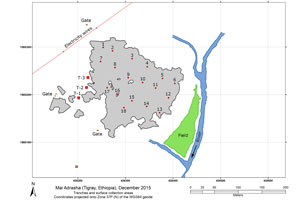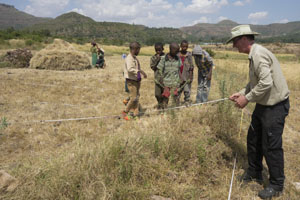| Just east of Indaselassie, about 80 km. west of Axum in the Tigray region of northern Ethiopia, are the now mostly destroyed remains of a large ancient settlement with monumental architecture just below the modern surface: |
|
Either hidden below
fields of teff (Eragrostis tef) or heavily
disturbed by recent gold-panning activities are
several construction phases of structures comprising
stone walls, platforms and pavements dating back to at
least 900 BCE:
|
|
|
|
|
 |
|
 |
|
|
|
|
|
|
To participate in
the Shire Archaeological Project in northern
Ethiopia, especially to assist with the
topographic and archaeological survey of the 99 km²
concession area, using differential GPS and ArcGIS, as
well as the instruction of graduate and undergraduate
students. |
|
|
|
- December
2014 - November-December 2015 - December 2016 - November-December 2017 - November-December 2018 - November-December 2019 In 2020 this project was suspended because of the Covid-19 pandemic and the outbreak of a civil war in the region. |
|
|
|
Students, staff and
faculty of the Shire
Archaeological Project, directed
in the field by Dr Willeke Wendrich, Rachel Moy, Cotsen
Institute of Archaeology (UCLA) and Dr Matthew Curtis. |
|
| Results: | |
A detailed topographic map and digital elevation model were made of the archaeological remains at Mai Adrasha. These are mostly destroyed by modern gold-panning in the sediments that buried the settlement after its abandonment at the beginning of the first millennium after Christ. A small area in the west of the ancient settlement appears preserved, partly below shrubbery and fields of teff (the locally domesticated cereal). |
| Approximate position and date of the site: | Mai Adrasha is
located 14°N 06' 42.55" / 38°E 19' 01.98" (UTM: 37P -
426300 E - 1560200 N), 1915 m. ASL in the Ethiopian
highlands, just east of the modern town of Indaselassie
and about 80 km west of Axum. Little is known about the
settlement or its wider environs from historical sources
or previous archaeological investigations. The site was built next to the permanent Gumelo river and preserves several large stone structures.
Many more have been destroyed by recent gold-panning
activities in the sediments that covered the site after
its abandonment Radiocarbon
analysis of stratified materials from Mai Adrasha
indicate that the settlement was at least intermittently
active between 1200 BCE and 200 CE. The 99 km² concession area east and south-east of Mai Adrasha appears to preserve numerous archaeological remains, including several more settlements as well as much older lithic scatters and rock shelters, some of which warrant intensive investigation in the near future. |
|
| Short description of the site: | The concession area
is in a still very rural part of Tigray, the
northern-most province of Ethiopia. The main language in
the region is Tigrinya, a
Semitic language related to modern Amharic and the
ancient language Ge'ez. All
three are written in a distinctive syllabic script,
originally developed to translate the Bible. Most
inhabitants adhere to Ethiopian Christianity or Sunni
Islam. Agriculture centers around teff, maize, chickpeas, green
chili peppers and several species of green leafy
vegetables. Common domesticated animals include sheep,
goat, cattle (Bos indicus
variants), donkey and dromedary (Camelus
dromedarius). These are mainly raised for their
labor or meat; milk and milk products are not regularly
consumed. Eggs are a staple part of the diet, chicken
and fish are not. The landscape displays evidence of recent geological activity, including volcanic and uplifted sedimentary rocks. This is related to the widening of the Great Rift, running from the great African lakes to the Dead Sea, and the genesis of the Ethiopian highlands around 70 million years ago. This great geological variety is complemented by a rich wildlife, with many species of birds and wild herbs. |
|
| Additional remarks: | My work in Ethiopia
would not have been possible without the Joan Silbee Chair in African Cultural
Archaeology, the Cotsen Institute of
Archaeology and the Institute for Field
Research. |
|
|
|
||
| HOME |